Spatiotemporal Variability in Snow and Land Cover in Sefid-Rud Basin, Iran
Abstract
:1. Introduction
- Visualizing and analyzing temporal changes in snow cover for the Sefid-Rud basin.
- Illustrating the spatiotemporal dynamic of average snow cover for each month of the winter, i.e., December, January, and February.
- Estimating the snow cover trend for the Sefid-Rud basin and its sub-basins for the period 2000–2019 by an MK trend analysis.
- Estimating and illustrating the snow cover trends with their statistical significance for the period 2000–2019 at annual, seasonal, and monthly scales by an MK trend analysis.
- Calculating the Pearson correlation between elevation and snow cover during the winter of each year for the Sefid-Rud basin.
- Illustrating land cover changes and investigating their relationships with snow cover dynamics.
2. Materials and Methods
2.1. Study Region
2.2. Datasets and Preprocessing
2.3. Methods
2.3.1. Mann–Kendall and Sen’s Slope Estimator
2.3.2. Pearson’s r
3. Results
3.1. Temporal Analysis of Snow Cover
3.2. Spatiotemporal Dynamic of Snow Cover
3.3. Snow Cover Trends for the Sefid-Rud Basin and Its Sub-Basins
3.4. Snow Cover Trend Results and Their Statistical Significance
3.5. Correlation Analysis Between Elevation and Snow Cover
3.6. Land Cover Change Results
4. Discussion
4.1. Snow Cover Dynamics in Time and Space
4.2. Comparisons with Similar Studies
4.3. Interrelations Between Snow Cover, Climate Change, and Land Cover
4.4. Limitations and Future Work
5. Conclusions
Author Contributions
Funding
Institutional Review Board Statement
Informed Consent Statement
Data Availability Statement
Acknowledgments
Conflicts of Interest
References
- Foster, J.; Liston, G.; Koster, R.; Essery, R.; Behr, H.; Dumenil, L.; Verseghy, D.; Thompson, S.; Pollard, D.; Cohen, J. Snow Cover and Snow Mass Intercomparisons of General Circulation Models and Remotely Sensed Datasets. J. Clim. 1996, 9, 409–426. [Google Scholar] [CrossRef]
- Yang, Z.L.; Dickinson, R.; Hahmann, A.; Niu, G.Y.; Shaikh, M.; Gao, X.; Bales, R.; Sorooshian, S.; Jin, J. Simulation of snow mass and extent in general circulation models. Hydrol. Process. 1999, 13, 2097–2113. [Google Scholar] [CrossRef]
- Cohen, S.; Koshida, G.; Mortsch, L. Climate and water availability indicators in Canada: Challenges and a way forward. Part III–Future scenarios. Can. Water Resour. J./Rev. Can. Ressour. Hydr. 2015, 40, 160–172. [Google Scholar] [CrossRef]
- Moore, T. Climate change and animal migration. Environ. Law 2011, 41, 393–405. [Google Scholar]
- Salomonson, V.; Appel, I. Estimating fractional snow cover from MODIS using the normalized difference snow index. Remote Sens. Environ. 2004, 89, 351–360. [Google Scholar] [CrossRef]
- Pan, M.; Zhao, F.; Ma, J.; Zhang, L.; Qu, J.; Xu, L.; Li, Y. Effect of Snow Cover on Spring Soil Moisture Content in Key Agricultural Areas of Northeast China. Sustainability 2022, 14, 1527. [Google Scholar] [CrossRef]
- Liang, S.; Li, X.; Zheng, X.; Jiang, T.; Li, X.; Qiao, D. Effects of Winter Snow Cover on Spring Soil Moisture Based on Remote Sensing Data Product over Farmland in Northeast China. Remote Sens. 2020, 12, 2716. [Google Scholar] [CrossRef]
- Safarianzengir, V.; Mahmoudi, L.; Meresht, R.; Abad, B.; Rajabi, K.; Kianian, M. Monitoring and Analysis of Changes in the Depth and Surface Area Snow of the Mountains in Iran Using Remote Sensing Data. J. Indian Soc. Remote Sens. 2020, 48, 1479–1494. [Google Scholar] [CrossRef]
- Barnett, T.; Adam, J.; Lettenmaier, D. Potential impacts of a warming climate on water availability in snow-dominated regions. Nature 2005, 438, 303–309. [Google Scholar] [CrossRef]
- Entezami, H.; Mojarrad, F.; Darand, M.; Shahabi, H. Investigating the Changes in Snow Cover in Sefidrood Drainage Basin using Remote Sensing. Geogr. Environ. Sustain. 2021, 11, 1–18. [Google Scholar]
- Barnett, T.; Adam, J.; Lettenmaier, D. Changing Arctic snow cover: A review of recent developments and assessment of future needs for observations, modelling, and impacts. Ambio 2016, 45, 516–537. [Google Scholar]
- Beniston, M.; Stoffel, M. Rain-on-snow events, floods and climate change in the Alps: Events may increase with warming up to 4 °C and decrease thereafter. Sci. Total Environ. 2016, 571, 228–236. [Google Scholar] [CrossRef] [PubMed]
- Manning, J.; Garton, E. Reconstructing historical snow depth surfaces to evaluate changes in critical demographic rates and habitat components of snow-dependent and snow-restricted species. Methods Ecol. Evol. 2012, 3, 71–80. [Google Scholar] [CrossRef]
- Muntán, E.; García, C.; Oller, P.; Martí, G.; García, A.; Gutiérrez, E. Reconstructing snow avalanches in the Southeastern Pyrenees. Nat. Hazards Earth Syst. Sci. 2009, 9, 1599–1612. [Google Scholar] [CrossRef]
- Zaghloul, M.; Ghaderpour, E.; Dastour, H.; Farjad, B.; Gupta, A.; Eum, H.; Achari, G.; Hassan, Q. Long Term Trend Analysis of River Flow and Climate in Northern Canada. Hydrology 2022, 9, 197. [Google Scholar] [CrossRef]
- Sharma, V.; Mishra, V.; Joshi, P. Snow cover variation and streamflow simulation in a snow-fed river basin of the Northwest Himalaya. J. Mt. Sci. 2012, 9, 853–868. [Google Scholar] [CrossRef]
- Zhao, Q.; Liu, Z.; Ye, B.; Qin, Y.; Wei, Z.; Fang, S. A snowmelt runoff forecasting model coupling WRF and DHSVM. Hydrol. Earth Syst. Sci. 2009, 13, 1897–1906. [Google Scholar] [CrossRef]
- Ahmad, S.; Israr, M.; Liu, S.; Hayat, H.; Gul, J.; Wajid, S.; Ashraf, M.; Baig, S.; Tahir, A. Spatio-temporal trends in snow extent and their linkage to hydro-climatological and topographical factors in the Chitral River Basin (Hindukush, Pakistan). Geocarto Int. 2020, 35, 711–734. [Google Scholar] [CrossRef]
- Immerzeel, W.; Droogers, P.; de Jong, S.; Bierkens, M. Large-scale monitoring of snow cover and runoff simulation in Himalayan river basins using remote sensing. Remote Sens. Environ. 2009, 113, 40–49. [Google Scholar] [CrossRef]
- Immerzeel, W.; Beek, L.V.; Bierkens, M. Climate change will affect the Asian water towers. Science 2010, 328, 1382–1385. [Google Scholar] [CrossRef]
- Kulkarni, A.V.; Rathore, B.P.; Singh, S.K.; Bahuguna, I.M. Understanding changes in the Himalayan cryosphere using remote sensing techniques. Int. J. Remote Sens. 2011, 32, 601–615. [Google Scholar] [CrossRef]
- Pant, N.; Kumar, M.; Rawat, J.; Rani, N. Study of snow cover dynamics of pinder watershed in Central Himalaya using remote sensing and GIS techniques. Int. J. Adv. Earth Sci. Eng. 2014, 3, 122–128. [Google Scholar]
- Tahir, A.; Chevallier, P.; Arnaud, Y.; Ashraf, M.; Bhatti, M. Snow cover trend and hydrological characteristics of the Astore River basin (Western Himalayas) and its comparison to the Hunza basin (Karakoram region). Sci. Total Environ. 2015, 505, 748–761. [Google Scholar] [CrossRef] [PubMed]
- Dietz, A.; Kuenzer, C.; Gessner, U.; Dech, S. Remote sensing of snow—A review of available methods. Int. J. Remote Sens. 2012, 33, 4094–4134. [Google Scholar] [CrossRef]
- Crawford, C. MODIS Terra Collection 6 fractional snow cover validation in mountainous terrain during spring snowmelt using Landsat TM and ETM+. Hydrol. Process. 2015, 29, 128–138. [Google Scholar] [CrossRef]
- Nolin, A. Recent advances in remote sensing of seasonal snow. J. Glaciol. 2010, 56, 1141–1150. [Google Scholar] [CrossRef]
- Selkowitz, D.; Forster, R.R. An automated approach for mapping persistent ice and snow cover over high latitude regions. J. Glaciol. 2015, 8, 16. [Google Scholar] [CrossRef]
- Mann, H. Nonparametric tests against trend. Econom. J. Econom. Soc. 1945, 13, 245–259. [Google Scholar] [CrossRef]
- Sen, P. Estimates of the Regression Coefficient based on Kendall’s Tau. J. Am. Stat. Assoc. 1968, 63, 1379–1389. [Google Scholar] [CrossRef]
- Militino, A.; Moradi, M.; Ugarte, M. On the Performances of Trend and Change-Point Detection Methods for Remote Sensing Data. Remote Sens. 2020, 12, 1008. [Google Scholar] [CrossRef]
- Shawky, M.; Ahmed, M.; Ghaderpour, E.; Gupta, A.; Achari, G.; Dewan, A.; Hassan, Q. Remote sensing-derived land surface temperature trends over South Asia. Ecol. Inform. 2023, 74, 101969. [Google Scholar] [CrossRef]
- Ghaderpour, E.; Mazzanti, P.; Bozzano, F.; Scarascia Mugnozza, G. Trend Analysis of MODIS Land Surface Temperature and Land Cover in Central Italy. Land 2024, 13, 796. [Google Scholar] [CrossRef]
- Azizi, G.; Rahimi, M.; Mohammadi, H.; Khoshakhlagh, F. Spatio-temporal variations of snow cover in the southern slope of central Alborz. Phys. Geogr. Res. 2017, 49, 381–393. [Google Scholar] [CrossRef]
- Anjum, M.; Ding, Y.; Shangguan, D.; Liu, J.; Ahmad, I.; Ijaz, M.; Khan, M. Quantification of spatial temporal variability of snow cover and hydro-climatic variables based on multi-source remote sensing data in the Swat watershed, Hindukush Mountains, Pakistan. Meteorol. Atmos. Phys. 2019, 131, 467–486. [Google Scholar] [CrossRef]
- Gao, J.; Williams, M.; Fu, X.; Wang, G.; Gong, T. Spatiotemporal distribution of snow in eastern Tibet and the response to climate change. Remote Sens. Environ. 2012, 121, 1–9. [Google Scholar] [CrossRef]
- Nemat, K. Analysis of Climate Change Impact on Glacier by Using Remote Sensing Data (Case Study: Alamkouh Glacier). Ph.D. Thesis, Tarbiat Modarres University, Tehran, Iran, 2014. [Google Scholar]
- Shafiq, M.; Ahmed, P.; ul Islam, Z.; Joshi, P.; Bhat, W. Snow cover area change and its relations with climatic variability in Kashmir Himalayas, India. Geocarto Int. 2019, 34, 688–702. [Google Scholar] [CrossRef]
- Malmros, J.; Mernild, S.; Wilson, R.; Tagesson, T.; Fensholt, R. Snow cover and snow albedo changes in the central Andes of Chile and Argentina from daily MODIS observations (2000–2016). Remote Sens. Environ. 2018, 209, 240–252. [Google Scholar] [CrossRef]
- Rathore, B.; Singh, S.; Jani, P.; Bahuguna, I.; Brahmbhatt, R.; Rajawat, A.; Randhawa, S.; Vyas, A. Monitoring of snow cover variability in Chenab Basin using IRS AWiFS sensor. J. Indian Soc. Remote Sens. 2018, 46, 1497–1506. [Google Scholar] [CrossRef]
- Molavi-Arabshahi, M.; Arpe, K.; Leroy, S. Precipitation and temperature of the southwest Caspian Sea region during the last 55 years: Their trends and teleconnections with large-scale atmospheric phenomena. Int. J. Climatol. 2016, 36, 2156–2172. [Google Scholar] [CrossRef]
- Hall, D.; Salomonson, V.; Riggs, G. MODIS/Terra Snow Cover 8-Day L3 Global 500 m SIN Grid; Version 5; NASA: Washington, DC, USA, 2006. [CrossRef]
- Riggs, G.; Hall, D.; Román, M. MODIS Snow Products Collection 6.1 User Guide; National Snow and Ice Data Center: Boulder, CO, USA, 2019. [Google Scholar]
- NASA/METI/AIST/Japan Spacesystems; U.S./Japan ASTER Science Team. ASTER Global Digital Elevation Model V003; NASA EOSDIS Land Processes Distributed Active Archive Center: Sioux Falls, SD, USA, 2019.
- Ratner, B. The correlation coefficient: Its values range between +1/−1, or do they? J. Target. Meas. Anal. Mark. 2009, 17, 139–142. [Google Scholar] [CrossRef]
- Taheri Dehkordi, A.; Valadan Zoej, M.; Ghasemi, H.; Ghaderpour, E.; Hassan, Q. A New Clustering Method to Generate Training Samples for Supervised Monitoring of Long-Term Water Surface Dynamics Using Landsat Data through Google Earth Engine. Sustainability 2022, 14, 8046. [Google Scholar] [CrossRef]
- Fattahi, E. Investigation of snow cover changes affected by climate change in North West of Iran. J. Appl. Res. Geogr. Sci. 2019, 19, 47–63. [Google Scholar] [CrossRef]
- Solaimani, K.; Darvishi, S.; Shokrian, F.; Rashidpour, M. Monitoring of temporal-spatial variations of snow cover using the MODIS image (Case Study: Kurdistan Province). Iran. J. Remote Sens. GIS 2018, 10, 77–104. [Google Scholar]
- Singh, D.; Gusain, H.; Mishra, V.; Gupta, N. Snow cover variability in North-West Himalaya during last decade. Iran. J. Remote Sens. GIS 2018, 11, 579. [Google Scholar] [CrossRef]
- Behling, R.; Roessner, S.; Foerster, S.; Saemian, P.; Tourian, M.; Portele, T.; Lorenz, C. Interrelations of vegetation growth and water scarcity in Iran revealed by satellite time series. Sci. Rep. 2022, 12, 20784. [Google Scholar] [CrossRef] [PubMed]
- Hall, D.K.; Riggs, G.A. Accuracy assessment of the MODIS snow products. Hydrol. Process. 2007, 21, 1534–1547. [Google Scholar] [CrossRef]
- Ghaderpour, E.; Pagiatakis, S.; Mugnozza, G.S.; Mazzanti, P. On the stochastic significance of peaks in the least-squares wavelet spectrogram and an application in GNSS time series analysis. Signal Process. 2024, 223, 109581. [Google Scholar] [CrossRef]
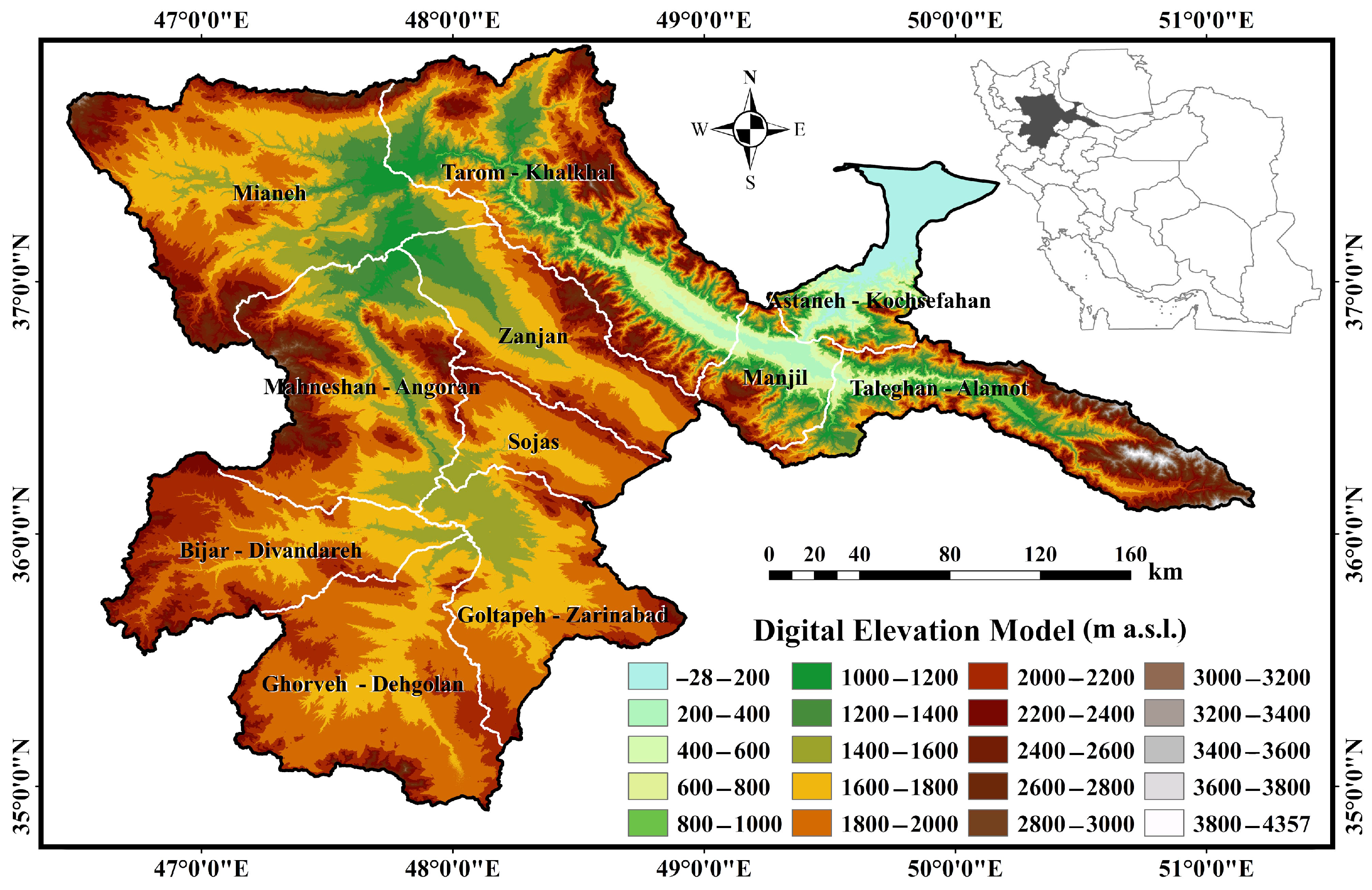



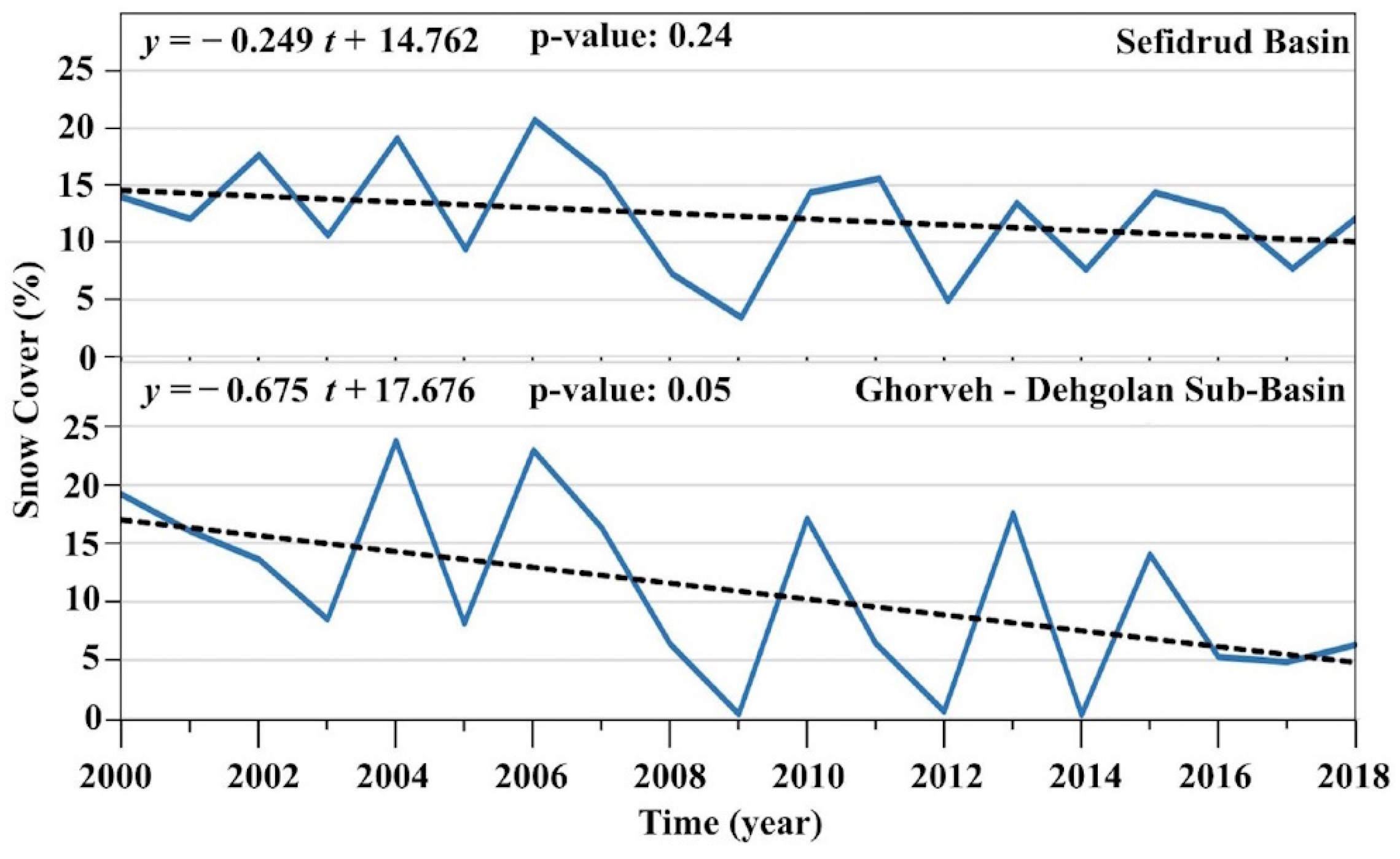
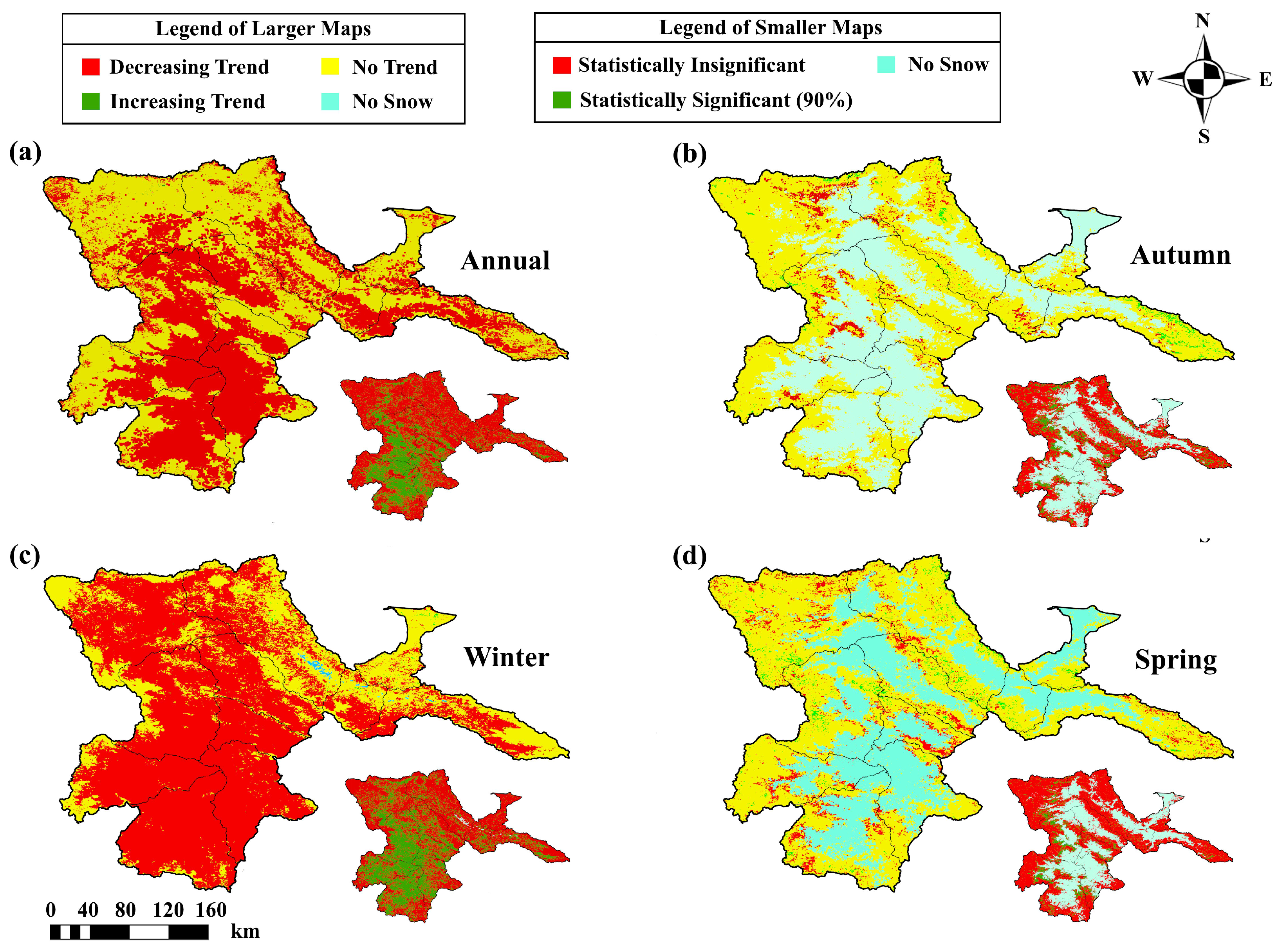

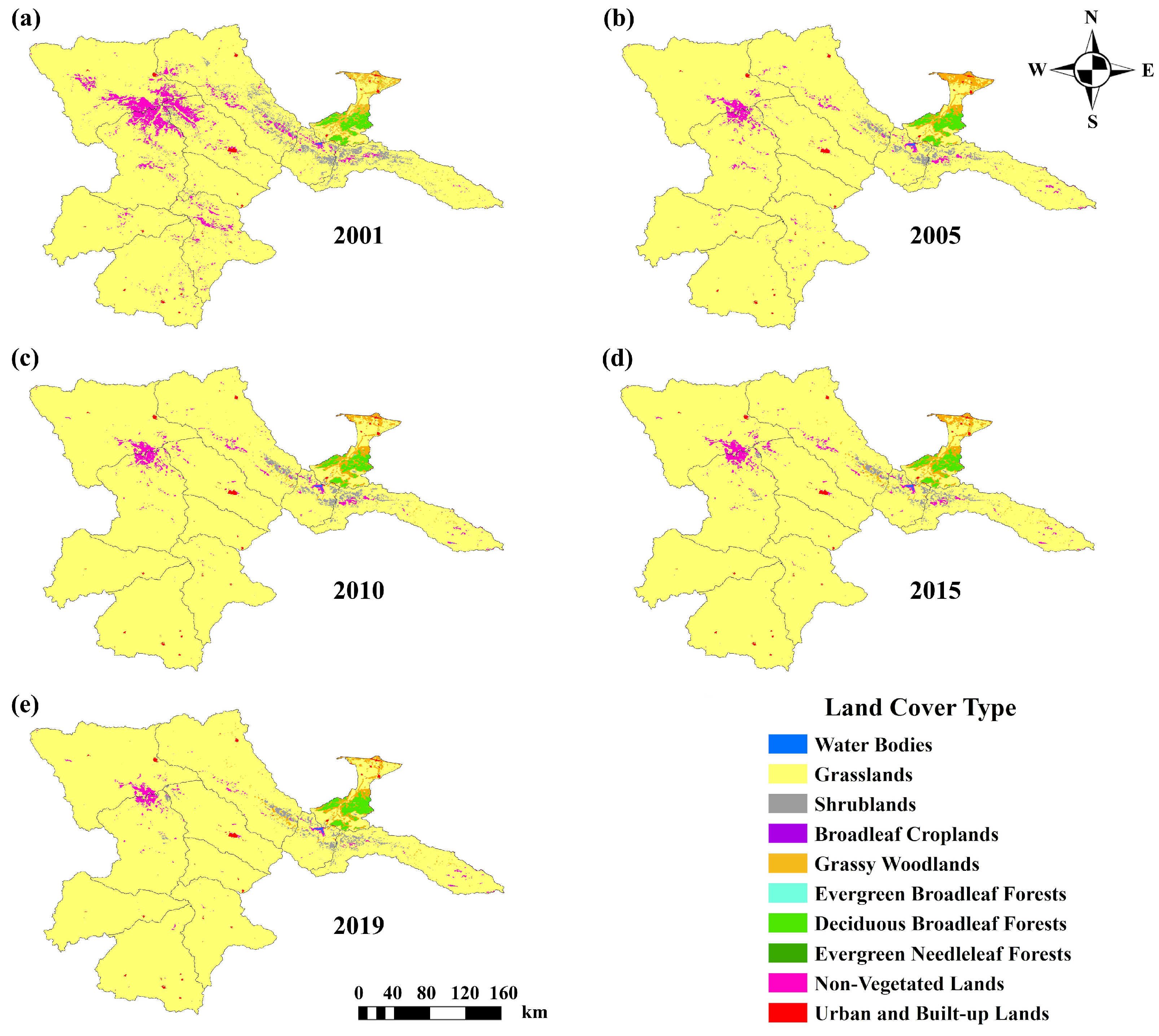
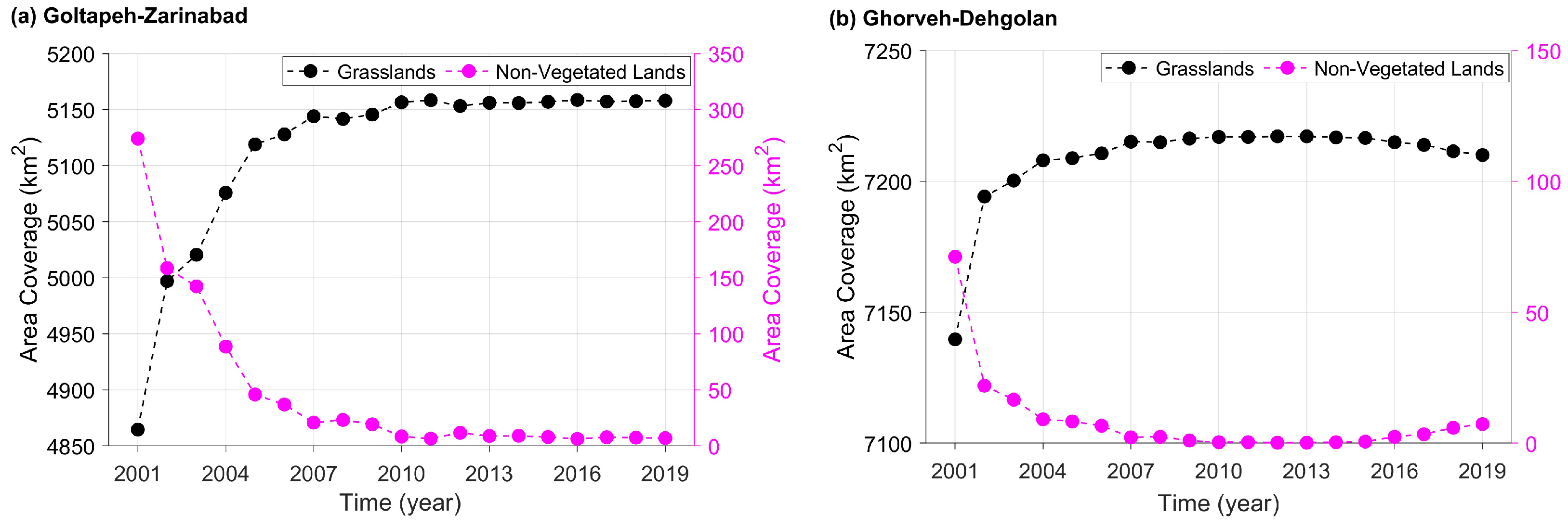
| Product | Period | Number of Images | Temporal Resolution | Spatial Resolution |
|---|---|---|---|---|
| ASTER GDEM | Since 2000 | 1 | − | 30 m |
| DOI: 10.5067/ASTER/ASTGTM.003 | ||||
| MODIS Snow Cover | 2000–2019 | 920 | 8 days | 500 m |
| DOI: 10.5067/MODIS/MOD10A2.006 | ||||
| MODIS Land Cover | 2001–2019 | 19 | Annual | 500 m |
| DOI: 10.5067/MODIS/MCD12Q1.061 |
| Basin/Sub-Basin | Sen’s Slope (%/year) | p-Value |
|---|---|---|
| Sefid-Rud basin | ||
| Goltapeh-Zarinabad | ||
| Ghorveh-Dehgolan | ||
| Sojas | ||
| Bijar-Divandareh | ||
| Mahneshan-Angoran | ||
| Zanjan | ||
| Mianeh | ||
| Manjil | ||
| Astaneh-Kochsefahan | ||
| Tarom-Khalkhal | ||
| Taleghan-Alamot |
| Year (Winter) | Pearson’s r | Year (Winter) | Pearson’s r |
|---|---|---|---|
| 2001 | 0.68 | 2011 | 0.80 |
| 2002 | 0.74 | 2012 | 0.64 |
| 2003 | 0.72 | 2013 | 0.61 |
| 2004 | 0.72 | 2014 | 0.70 |
| 2005 | 0.74 | 2015 | 0.60 |
| 2006 | 0.72 | 2016 | 0.78 |
| 2007 | 0.81 | 2017 | 0.59 |
| 2008 | 0.73 | 2018 | 0.70 |
| 2009 | 0.69 | 2019 | 0.70 |
| 2010 | 0.63 |
Disclaimer/Publisher’s Note: The statements, opinions and data contained in all publications are solely those of the individual author(s) and contributor(s) and not of MDPI and/or the editor(s). MDPI and/or the editor(s) disclaim responsibility for any injury to people or property resulting from any ideas, methods, instructions or products referred to in the content. |
© 2024 by the authors. Licensee MDPI, Basel, Switzerland. This article is an open access article distributed under the terms and conditions of the Creative Commons Attribution (CC BY) license (https://creativecommons.org/licenses/by/4.0/).
Share and Cite
Entezami, H.; Mojarrad, F.; Shahabi, H.; Ghaderpour, E. Spatiotemporal Variability in Snow and Land Cover in Sefid-Rud Basin, Iran. Sustainability 2024, 16, 9381. https://doi.org/10.3390/su16219381
Entezami H, Mojarrad F, Shahabi H, Ghaderpour E. Spatiotemporal Variability in Snow and Land Cover in Sefid-Rud Basin, Iran. Sustainability. 2024; 16(21):9381. https://doi.org/10.3390/su16219381
Chicago/Turabian StyleEntezami, Hersh, Firouz Mojarrad, Himan Shahabi, and Ebrahim Ghaderpour. 2024. "Spatiotemporal Variability in Snow and Land Cover in Sefid-Rud Basin, Iran" Sustainability 16, no. 21: 9381. https://doi.org/10.3390/su16219381
APA StyleEntezami, H., Mojarrad, F., Shahabi, H., & Ghaderpour, E. (2024). Spatiotemporal Variability in Snow and Land Cover in Sefid-Rud Basin, Iran. Sustainability, 16(21), 9381. https://doi.org/10.3390/su16219381







